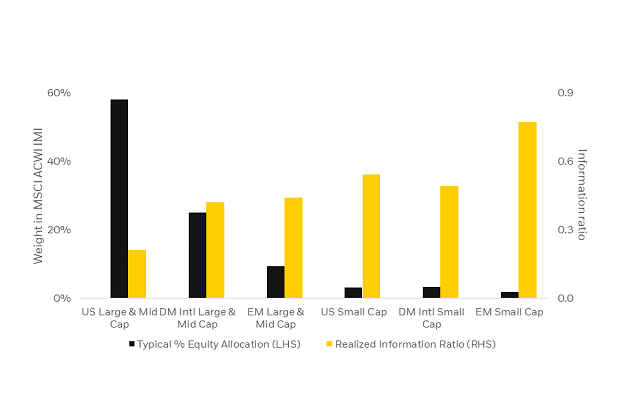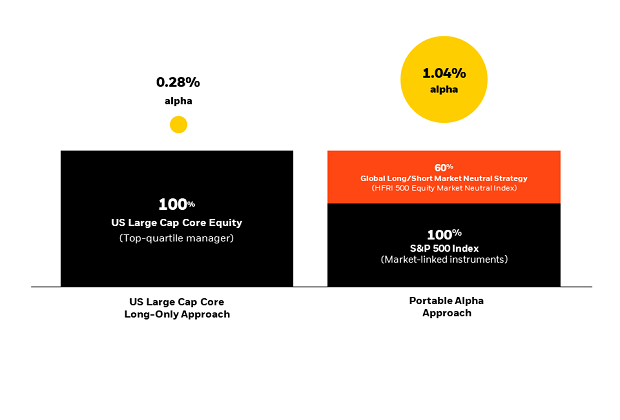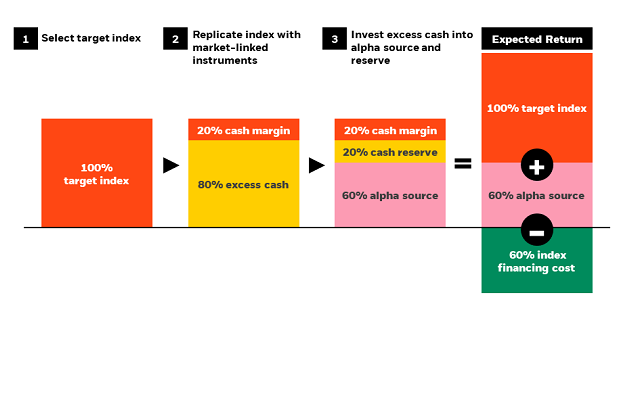
Portable alpha strategies
Key points
-
01
Unlock portfolio capital
Portable alpha strategies, which separate alpha and beta components of traditional asset classes, can help investors increase overall portfolio performance and maintain a diversified asset allocation.
-
02
Fixing the alpha-beta mismatch
In equity portfolios, we believe that portable alpha can help redirect active risk budgets towards areas where alpha may be more abundant—unlocking capital in the largest part of investors’ portfolios.
-
03
Navigating a higher rate environment in fixed income
In fixed income portfolios, we believe that portable alpha strategies can help investors achieve the dual goals of potential enhanced returns and meaningful portfolio diversification.
Defining portable alpha
The objective of a portable alpha strategy is to generate outperformance over a specific index. Portable alpha strategies consist of a target index exposure, or “beta” component, and a separate source of excess returns, or “alpha” component.
Portable alpha strategies seek to effectively separate the returns of a target index (beta) and the returns of an alpha-seeking manager (alpha). This separation potentially allows the returns of the alpha component to be “ported” on top of the investor’s desired market index exposure.
Mechanics of portable alpha strategies
There are three key steps to implement a portable alpha strategy. First, the investor chooses a target index for their beta exposure. Second, the target index is replicated using market-linked instruments. This part of the portfolio requires a small amount of cash in the form of a margin requirement to achieve the exposure, but also comes with a cash financing cost. As a result, there is excess cash to allocate capital. The final step is to invest the remaining funds in an alpha source and a cash reserve.
Example implementation and expected potential return of a portable alpha strategy
The above illustration is based on a hypothetical analysis and is not indicative of the future performance. The hypothetical performance returns are provided for illustrative purposes only and are not meant to be representative of actual performance returns of, or to project or predict returns for, any account, portfolio, strategy or asset allocation. The hypothetical performance period is from June 30, 2023. The displayed hypothetical returns are subject to a number of limitations. They are illustrative of a product or strategy that does not exist, and therefore do not reflect the deduction of any fees or expenses, including advisory, management and performance fees, as well as brokerage fees, commissions and other expenses that might normally apply. In addition, the allocation decisions reflected in the hypothetical returns were not made under actual market conditions and cannot completely account for the impact of financial risk in actual portfolio management. The performance shown above is hypothetical and does not represent the investment performance or the actual accounts of any investor(s) or any fund(s). The strategies with hypothetical performance were selected with the full benefit of hindsight, after their performance over the period shown was known. Past hypothetical performance results are not indicative of future returns. The performance shown does not represent any existing portfolio, and as such, is not an investible product. The underlying performance is based on actual historical performance. The aggregate performance of the model is hypothetical and the model is formulated with benefit of hindsight. There are frequently sharp differences between a hypothetical performance record and the actual record subsequently achieved. Therefore, hypothetical performance records invariably show positive rates of return. Another inherent limitation of these results is that the allocation decisions reflected in the performance record were not made under actual market conditions and, therefore, cannot completely account for the impact of financial risk in actual portfolio management.
There is no guarantee expected returns will be realized. For illustrative purposes only. There is no guarantee expected returns will be realized. Not to depict actual data. “Expected potential return” in the chart above assumes a 20% cash reserve and 20% cash margin that can be reinvested at the same rate as the cash financing cost to fund the market-linked instruments. Thus, the expected return is equal to the return of 100% market index plus 60% alpha source minus 60% cash financing rate.
Thus, the return of the portable alpha framework is determined by how much capital is allocated to the alpha source, how much return it generates, the return of the index exposure, and the cost to finance the index exposure. It is important to note that in a portable alpha framework, the alpha-seeking manager is additive to the portfolio as long as they produce positive returns greater than the cost to finance the index exposure.
Understanding expected returns
Using the simplified example in the chart above, let’s assume that 100% of the target index exposure is created using market-linked instruments at a financing cost of 1.0%. Due to the fact that 40% of the index exposure is backed by physical cash (20% margin and 20% reserve), it can be reinvested in a cash rate to match the financing cost rate. Thus, the remaining 60% of exposure comes at a cost of 0.6%
Next, the alpha-seeking manager seeks some level of positive return. As 60% of the overall portfolio is invested with the alpha-seeking manager, the investor would receive 60% of the return generated by the manager. If the alpha-seeking manager targeted a 5% return, then the overall investment would receive the expected return of the target index and an additional 3% from the alpha source, minus 0.6% for the cash financing cost.
Overall, in this hypothetical example, the investor’s return could equate to the market index return plus 2.4%
Potential risks
Like all investments, there are potential risks involved in a portable alpha framework. Primarily, it is possible for the alpha-seeking manager to underperform the cash rate or generate negative absolute returns. Market-linked instruments may not perfectly track a market index over time, creating tracking error that may differ from initial return expectations. Secondarily, market-linked instruments have the potential for margin calls after large market moves that may require adjustments in the whole portfolio.
Putting portfolio capital to productive use
One key advantage of a portable alpha framework is investors can untether a portfolio’s active risk budget from the beta allocation without disturbing it. Importantly, it unlocks portfolio capital to seek excess returns in areas of the global financial markets with the highest potential to generate alpha. For investors, building the optimal asset allocation for the market return, or “beta” component, of your portfolio is quite different than the optimal capital allocation seeking excess returns, or “alpha” component, of your portfolio.
Portable alpha unlocks portfolio capital to be used to seek excess returns in areas of the global financial markets that have the highest potential to generate alpha.
In equity portfolios, we find that market capitalization is a common driver of portfolio asset allocation weights, but it is not an optimal starting point for active risk allocation. In fixed income portfolios, we find that most managers have low active risk budgets and derive the majority of their active return from tilts into credit-sensitive securities—essentially delivering beta and a potentially high correlation to equities.
Portable alpha strategies can help solve these issues across both asset classes. They can allocate active risk based on other alpha opportunity sets in equities, and they may help construct a more diversified source of active return than traditional bond portfolios.
Fixing the alpha-beta mismatch in equities
The concentrated nature of capitalization-weighted indices is a difficult starting point for active risk budgeting, as it dramatically tilts the portfolio allocations away from the more diverse, high-breadth market segments. The figure below breakdowns the MSCI ACWI IMI into conventional segments in which clients typically organize their equity allocations.
While following capitalization-weighted indices can be a well-prescribed starting point for an overall equity market beta allocation, it can also have consequences on the effectiveness of alpha-seeking efforts. Most notably, the amount of capital allocated to active managers in each category is typically bound with its market cap weighting in the broader index.
For example, US large and mid cap exposure is typically over half the overall equity allocation, while international large cap is roughly a quarter. The other more diverse equity segments, and where risk-adjusted returns potential may be greater based on top-quartile manager returns, combine to be just under 25% of the total equity exposure.
Market cap equity allocation is misaligned with alpha potential
MSCI ACWI IMI segment allocations and realized 10-yr Information Ratios of top-quartile managers

The above illustrative examples are for illustrative purposes only; they are not meant as a guarantee of any future results or experience, and should not be interpreted as advice or a recommendation. This case study is shown for illustrative purposes only, and was selected to demonstrate the dimensions of active risk budgeting and manager selection. There is no guarantee than an actual strategy will be executed or executed as shown above, or that if executed, will be profitable. This investment case study was selected as it represents asset class limitations. This case study does not predict future results, even if a similar strategy is used.
Source: MSCI, eVestment, BlackRock as of June 30, 2023. “Typical % Equity Allocation” represented by the market-capitalization weights of the MSCI ACWI IMI Index. “Segment Breadth” represented by the number of securities in the given segment of the MSCI ACWI IMI Index. Information ratio is a measure of an active manager’s ability to generate risk-adjusted excess returns versus a representative market benchmark. It is calculated as Manager Skill (Information Co-Efficient) multiplied by the Square Root of Breadth (# of securities in segment). “Information Ratio Potential” assumes an Information Coefficient of 0.01 for each market segment of the MSCI ACWI IMI Index. “Realized Information Ratio” is the observed 10-year information ratio for the top quartile managers in the eVestment database for each market segment. Indices are unmanaged and one cannot invest directly in an index. Past performance is not a reliable indicator of current or future results.
Manager selection can only go so far
In our experience, finding persistently skilled, top-quartile performing managers can be a challenge. Exceptional manager selection is still bound by asset class limitations.
As shown in the chart above, even if you were successful in identifying a top-quartile manager in the US large and mid-cap segment, the overall portfolio impact might be muted. Why? Selecting a top-quartile manager in the segment would have only resulted in an information ratio of 0.21 on about 58% of your total equity allocation. On the other hand, selecting a top-quartile domestic market international small cap manager would have been far more rewarding with an information ratio of 0.49, but that would likely only be a small portion (<5%) of your total portfolio.
Manager selection matters less if the starting point of an asset allocation is not aligned with alpha opportunities. Portable alpha can help with this alpha-beta mismatch.
Putting portable alpha to work in equities
What are the potential benefits of a portable alpha framework in equities? Broader opportunities to generate alpha in the largest parts of the portfolio where meaningful outperformance may be difficult.
Let’s assume we want to generate more return from a US large cap allocation. If we use a portable alpha approach to replicate S&P 500 beta exposure and make a 60% investment into an alternative strategy such as a global long/short market neutral strategy, the portfolio outcomes can be much more impactful than manager selection alone.
Global long/short market neutral strategies are typically high-breadth portfolios that are able to look across global equity markets for opportunities, not just a particular market segment like US Large Cap securities. Importantly, because these types of strategies take both long and short positions, they often seek to take advantage of security dispersion in markets, and do not add significantly more beta exposure. As a result, the returns can be less dependent on market direction. This type of uncorrelated return profile can potentially act as a compliment to the index exposure in up markets and a buffer against volatility in down markets.
The figure below compares the alpha generated by the top-quartile of US large cap core equity manager to a portable alpha framework that replicates the S&P 500 Index through market-linked instruments while holding a 60% allocation to an alternative strategy, represented by the HFRI 500 Equity Market Neutral Index.
Traditional long-only results compared to a portable alpha approach
Hypothetical 10-year annual alpha generation by approach

The above illustrative examples are for illustrative purposes only; they are not meant as a guarantee of any future results or experience, and should not be interpreted as advice or a recommendation. The above illustrations are based on a hypothetical analysis and are not indicative of the future performance. The hypothetical performance returns are provided for illustrative purposes only and are not meant to be representative of actual performance returns of, or to project or predict returns for, any account, portfolio, strategy or asset allocation. The hypothetical performance period is from eVestment database as of June 30, 2023. The displayed hypothetical returns are subject to a number of limitations. They are illustrative of a product or strategy that does not exist, and therefore do not reflect the deduction of any fees or expenses, including advisory, management and performance fees, as well as brokerage fees, commissions and other expenses that might normally apply. In addition, the allocation decisions reflected in the hypothetical returns were not made under actual market conditions and cannot completely account for the impact of financial risk in actual portfolio management. The performance shown above is hypothetical and does not represent the investment performance or the actual accounts of any investor(s) or any fund(s). The strategies with hypothetical performance were selected with the full benefit of hindsight, after their performance over the period shown was known. Past hypothetical performance results are not indicative of future returns. The performance shown does not represent any existing portfolio, and as such, is not an investible product. This represents the model-driven allocations, depicted above, to the underlying top-quartile (25th percentile rank) manager in the eVestment Large Cap Core category. The underlying performance is based on actual historical performance. The aggregate performance of the model is hypothetical and the model is formulated with benefit of hindsight. There are frequently sharp differences between a hypothetical performance record and the actual record subsequently achieved. Therefore, hypothetical performance records invariably show positive rates of return. Another inherent limitation of these results is that the allocation decisions reflected in the performance record were not made under actual market conditions and, therefore, cannot completely account for the impact of financial risk in actual portfolio management.
Source: eVestment database as of June 30, 2023. “Traditional Long-Only Approach” alpha data based on the 10-year average annual alpha generated over the S&P 500 Index for the top-quartile (25th percentile rank) manager in the eVestment U.S. Large Cap Core category. The index return was 12.85% and the manager return was 13.13%. “Portable Alpha Approach” alpha calculated as 60% of the average annual return of the HFRI Equity Market Neutral Index minus 60% of the ICE BofA 3-Month Treasury Bill Index. The HFRI index return was 2.72% and the T-Bill return was 0.98%. The HFRI Indices are global, equal-weighted indices comprised of the largest alternative funds published by Hedge Fund Research, Inc. Indices are unmanaged and one cannot invest directly in an index. Past performance is not a reliable indicator of current or future results.
As you can see, the realized 10-year annualized alpha of a top-quartile manager is 0.28%. In comparison, 60% of the HFRI 500 Equity Market Neutral Index return of 2.72% (which represents the average return of the managers in the category) results in an annual alpha of 1.63%. After adjusting for 60% of the 0.98% average annual financing costs of the beta exposure over the time period (as measured by the ICE BofA 3-Month Treasury Bill Index) the total alpha of the approach is 1.04% annually. As you can see, the distinct structure of a portable alpha strategy may lead to greater return potential than what is possible through manager selection alone.
In a portable alpha framework, untethering alpha generation from the confines of market-cap weighted asset allocations allows investors to optimize return potential away from segments of the markets that are typically the largest, but also the hardest to generate meaningful excess returns.
Navigating a higher rate environment in fixed income
Rising yields for global fixed income securities have boosted their appeal, but a higher inflation environment, coupled with increased dispersion, and lower diversification benefits between bonds and equities provide new challenges for investors. Core fixed income, as a major portion of some investors’ asset allocations, may no longer work to cushion against risk asset selloffs or the best use of portfolio capital. Compared to traditional long-only approaches, portable alpha strategies can help investors generate higher levels of active risk in their portfolio, and these strategies can allow investors to generate a higher percentage of idiosyncratic active risk in their return stream. In this analysis, we look at Core and CorePlus U.S. fixed income managers to illustrate how portable alpha strategies can improve an investor’s return potential and reduce overall portfolio correlation to the credit and equity markets.
Source of active return matters
In the figure below, we regressed 10 years of Core Bond and CorePlus manager returns against a simple three factor model which included credit risk, equity risk, and rate risk. We found that approximately 60% of Core Bond managers and 68% of CorePlus managers’ excess returns were explained by these static exposures.
Bond manager excess returns largely explained by tilts to credit risk
Manager excess return composition

The above illustrative examples are for illustrative purposes only; they are not meant as a guarantee of any future results or experience, and should not be interpreted as advice or a recommendation. Indices are unmanaged and one cannot invest directly in an index. Past performance is not a reliable indicator of current or future results. Diversification may not fully protect you from market risk. The above illustrations are based on a hypothetical analysis and are not indicative of the future performance. The hypothetical performance returns are provided for illustrative purposes only and are not meant to be representative of actual performance returns of, or to project or predict returns for, any account, portfolio, strategy or asset allocation. The hypothetical performance period is from eVestment database as of June 30, 2023. The displayed hypothetical returns are subject to a number of limitations. They are illustrative of a product or strategy that does not exist, and therefore do not reflect the deduction of any fees or expenses, including advisory, management and performance fees, as well as brokerage fees, commissions and other expenses that might normally apply. In addition, the allocation decisions reflected in the hypothetical returns were not made under actual market conditions and cannot completely account for the impact of financial risk in actual portfolio management. The performance attribution shown above is hypothetical and does not represent the investment performance or the actual accounts of any investor(s) or any fund(s). The strategies with hypothetical performance were selected with the full benefit of hindsight, after their performance over the period shown was known. Past hypothetical performance results are not indicative of future returns. The performance shown does not represent any existing portfolio, and as such, is not an investible product. This represents the regressed returns of managers in the eVestment Core Bond and CorePlus Bond categories. The underlying performance is based on actual historical performance. The aggregate performance is hypothetical and is formulated with benefit of hindsight. There are frequently sharp differences between a hypothetical performance record and the actual record subsequently achieved. Therefore, hypothetical performance records invariably show positive rates of return.
Source: eVestment database, as of June 30, 2023. Based on the active return versus the category benchmark over the past 10 years. Core managers benchmarked to Bloomberg U.S. Aggregate Bond Index. CorePlus managers benchmarked to Bloomberg U.S. Universal Index. Indices are unmanaged and one cannot invest directly in an index. For illustrative purposes only. Past performance is not a reliable indicator of current or future results.
Of the three factors, the credit risk factor exposure was most explanatory. This implies that many active Core and CorePlus bond managers have relied on an overweight to credit-sensitive securities to drive excess return.
This has a very important, but often overlooked, effect on total portfolio diversification. The credit overweight may boost returns in up markets, but it may also result in larger fixed income drawdowns in periods of equity sell-offs—the very time when investors may need the diversification of core bonds.
Putting portable alpha to work in fixed income
What are the potential benefits of a portable alpha framework in core fixed income? The ability to increase active returns and at the same time seek idiosyncratic, equity-diversifying return streams.
Instead of chasing yields in fixed income markets, using alternative strategies as the alpha source in a portable alpha framework can help maintain the equity diversifying returns investors come to expect from bond allocations. Alternatives, like multi-strategies are more focused on idiosyncratic return streams that are the result of relative value or long/short security selection opportunities.
The figure below compares the alpha generated by the top-quartile Core and CorePlus bond managers to a portable alpha framework that replicates the given benchmark while holding a 60% allocation to an alternative strategy, represented by the HFRI 500 Relative Value Multi-Strategy Index.
As you can see, the realized 10-year annualized alpha of a top-quartile manager is 0.66% and 1.17%, respectively. In comparison, a portable alpha strategy with a 60% allocation to the median multi-strategy manager would have resulted in total alpha of 1.69% annually, after adjusting for financing costs.
Comparing results of a traditional long-only and portable alpha approach
Hypothetical annual alpha generation based on approach

The above illustrations are based on a hypothetical analysis and are not indicative of the future performance. The hypothetical performance returns are provided for illustrative purposes only and are not meant to be representative of actual performance returns of, or to project or predict returns for, any account, portfolio, strategy or asset allocation. The hypothetical performance period is from eVestment database and HFRI 500 Indices as of June 30, 2023. The displayed hypothetical returns are subject to a number of limitations. They are illustrative of a product or strategy that does not exist, and therefore do not reflect the deduction of any fees or expenses, including advisory, management and performance fees, as well as brokerage fees, commissions and other expenses that might normally apply. In addition, the allocation decisions reflected in the hypothetical returns were not made under actual market conditions and cannot completely account for the impact of financial risk in actual portfolio management. The performance shown above is hypothetical and does not represent the investment performance or the actual accounts of any investor(s) or any fund(s). The strategies with hypothetical performance were selected with the full benefit of hindsight, after their performance over the period shown was known. Past hypothetical performance results are not indicative of future returns. The performance shown does not represent any existing portfolio, and as such, is not an investible product. This represents the model-driven allocations, depicted above, to the underlying top-quartile (25th percentile rank) manager in the respective eVestment category. The underlying performance is based on actual historical performance. The aggregate performance of the model is hypothetical and the model is formulated with benefit of hindsight. There are frequently sharp differences between a hypothetical performance record and the actual record subsequently achieved. Therefore, hypothetical performance records invariably show positive rates of return. Another inherent limitation of these results is that the allocation decisions reflected in the performance record were not made under actual market conditions and, therefore, cannot completely account for the impact of financial risk in actual portfolio management.
Source: eVestment database, as of June 30, 2023. “Core Bond Long-Only Approach” alpha data based on the 15-year average annual alpha generated over the Bloomberg Barclays U.S. Aggregate Bond Index for the top quartile (25th percentile rank) manager in the eVestment U.S. Core Bond category. “Core Bond Long-Only Approach” alpha data based on the 10-year average annual alpha generated over the Bloomberg Barclays Universal Bond Index for the top quartile (25th percentile rank) manager in the eVestment U.S. CorePlus Bond category. “Portable Alpha Approach” alpha calculated as 60% of the average annual return of the HFRI 500 Relative Value Multi-Strategy Index minus 60% of the ICE BofA 3-Month Treasury Bill Index. The HFRI 500 Indices are global, equal-weighted indices comprised of the largest alternative funds published by Hedge Fund Research, Inc. Indices are unmanaged and one cannot invest directly in an index. Past performance is not a reliable indicator of current or future results.
Once again, we believe the structural advantage of the portable alpha strategy can translate to better returns even against top-performing managers in the category. During this time when investors are struggling with greater uncertainty in financial markets, portable alpha strategies can represent away for investors to increase the overall level of potential return from their core allocations. Equally important, portable alpha can help preserve the diversifying role of bonds by seeking more idiosyncratic sources of return that are less correlated with credit risk.
Rediscovering Portable Alpha
Explore how investors are defining portable alpha and implementing strategies designed to increase overall performance and maintain a diversified asset allocation.
Download the full report on portable alpha strategies








